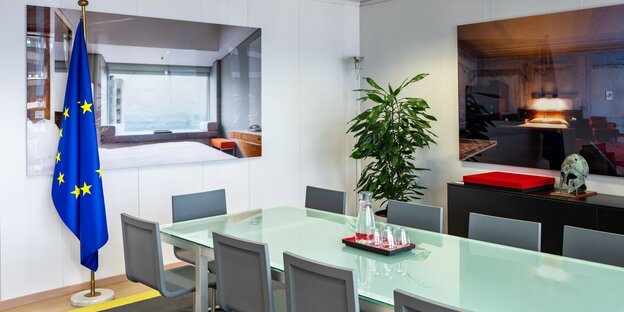Twilight in the front room: Suzanne Schols, a former EU lobbyist, has published a photo book about the non-aesthetic nature of office landscapes in the EU.
Conference table in Frans Timmerman’s office Photo: Photo: Suzanne Schols/©HousePublishing 2023
There are an estimated 30,000 European lobbyists in Brussels for 751 members of the EU Parliament or their staff and those of the European Commission. The lobby, from which lobbyists get their name, was once considered an antechamber where politicians and the population met.
Now it seems rather to be the antechamber for a network of offices, corridors and rooms, for opaque information and – as the Qatargate scandal in 2022 showed – also for corruption. Of course, no one in Brussels wants to be called a “lobbyist”.
The conceptual photographer Suzanne Schols would like some more transparency in the run-up to the European elections. For her illustrated book ‘Lobby. Between Green Deals and Ideals, she visits places where key EU influencers work and discovers a functionally bleak reality.
Visual journey of discovery
Schols, originally from the Netherlands and born in 1986, had worked as an advisor at the European Commission and only later switched sides: “As a former lobbyist who became a visual artist, I wanted to make a visual journey through the Brussels lobbying world as I know it. .”
The first photo in her book shows the office by Frans Timmermans, Executive Vice President until 2023 of the European Commission and head of the European Green Deal. At the end of a reflective conference table hangs a photo overlooking a high hotel window. What happens here and outside the book in the hotel lobby?
What deals emerge between offices and top restaurants aren’t shown? And what siren songs between temptation, offer and emphasis do the pressure groups sound? Schols’ second photo shows a lobby in the European Council building, decorated with flags and a red carpet. Here, on an area that would represent 450 million Europeans, the 30,000 European lobbyists would have to walk all the time, but the entire book lies abandoned.
Between entrance and administration
The core of the publication is the almost endless succession of offices of the lobby organizations themselves quite comfortable seats. Monochrome carpets and pseudo-transparent glass walls dampen the sound.
Logos, posters and brochures promote the cause in patient rhetoric. This looks like one of those mid-range furniture stores. But the oppressive feeling of the waiting room at the dentist also creeps in.
Schols’ project is structured according to the categories of the EU Transparency Register. Organizations that influence the policies of the EU institutions are listed here. They range from consultancies, law firms and industry associations to NGOs, religious organizations or think tanks.
Highlighted mnemonics
“Transparency and accountability are essential for maintaining the confidence of EU citizens in the legitimacy of the Union’s political, legislative and administrative processes,” is a sentence emphasized in the highlight that Schols included in her book from an official EU magazine prints.
The reality is different. 31 of the 122 organizations requested to appear on the publicly available meeting lists four or more times and an office in Brussels denied her access. They are marked by blank pages. These include Airlines for Europe, Plastics Europe, Swedish Forest Industries Federation, ArcelorMittal and BASF SE.
In an almost flattering pedantry, Schols lists all 31 companies, always with the same “Access denied” or “Multiple requests received no response” – the refusal of some lobbyists does not simply allow them to continue. “Is there a visual form that can interrogate its many layers?”, the artist asks, looking for transparency in printed frames, timelines or along indexical photographs.
Her photo essay examines the spaces rather than the lobby, which can be criticized. With her uncomfortably austere visual frame, Schols reflects a stereotypical image of ‘the’ EU and at the same time conveys the brutally boring everyday life.
Bertold Brecht had doubts in 1931 “The Threepenny Opera”, that by photographing a building you can draw conclusions about the production there: “The actual reality has ended up in the functional.” Viewed in this way, Suzanne Schols’ attempt to detect lobbyism by photographing lobbies can only fail. But along the pages of the book you can still see how there is hardly any social space ‘between green deals and ideals’.
